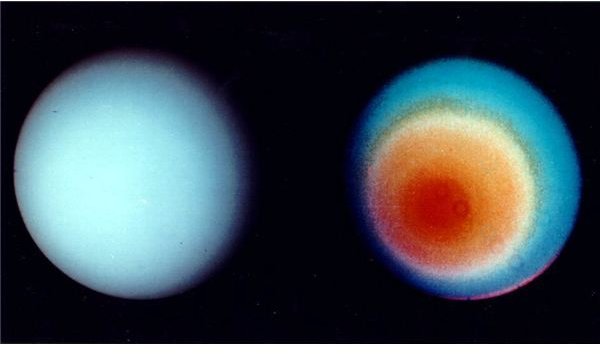What's the Weather on Uranus?
Uranus, Some Basic Facts
Uranus, the seventh planet from the Sun, is the third largest and fourth most massive planet as well. Although it is just visible to the naked eye, ancient astronomers were never able to identify it as a planet because of its long orbit. It became the first planet to be discovered in modern times when the British astronomer William Herschel found it in 1781. The planet is named after the Greek god of the sky, Uranus, who is the father of Cronos. One of the strangest features of Uranus is its odd tilt. Every other planet in the solar system rotates around its axis at roughly 90 degrees to the plane of orbit. The Earth’s orbit is slightly off (23°), giving us pronounced seasons. The axis of Uranus is almost parallel with the plane of orbit, meaning that its north and south poles are located where its equator should be. This odd characteristic gives Uranus some of the strangest weather in the Solar System.
Weather on Uranus
Suppose that you were taking a stroll on the surface of Uranus. Unfortunately for you, you had no idea what the weather would be like

there and you would only last a few seconds before you died a terrible, terrible death. But in those few seconds, here is what you might be able to gleam from this alien planet. First and foremost, it would be cold. Uranus is more than twenty times further from the Sun than the Earth, and has a temperature ranging from 49 to 57 degrees above absolute zero, which is equal to -460 degrees Fahrenheit. The extreme temperature of Uranus makes the atmosphere very icy, and you might even be lucky enough to see a snow storm. Unfortunately, most of the snow would be poisonous to humans as it is composed of water, ammonia, ammonium hydrosulfide, and methane.
Another interesting thing you might notice is the atmosphere of Uranus. Viewed from Earth, it appears as a brilliant blue cloud covering the planet. It is composed mainly of hydrogen, but also includes amounts of helium, methane, and hydrogen deuteride. The winds on Uranus resemble the other gas giants in the Solar System, and take the form of several bands that wrap around the planet. If you happened to be standing near the equator, you would be hit with winds up to 540 miles per hour. Of course this situation of purely hypothetical; if you actually were to talk on the surface of Uranus you would end up drowning. The planet has no definable surface, and instead goes from a gas to a liquid state as the pressure increases.
Just the Facts
Temperature: 49 - 57K (-371 - -460 Fahrenheit)
Atmosphere: 83% hydrogen, 15% helium, 2.3% methane, trace amounts of hydrogen deuteride
Ices: water, ammonia, methane, ammonium hydrosulfide
Day/Night Cycle: 42 years
Wind Speed: 0-540 miles per hour (250 m/s)
Sources
https://adsabs.harvard.edu/abs/1995P%26SS...43.1517P
https://nssdc.gsfc.nasa.gov/planetary/factsheet/uranusfact.html
https://solarsystem.nasa.gov/planets/profile.cfm?Object=Uranus&Display=Facts
Credits:
Uranus with Rings: https://www.nasa.gov/images/content/105700main_telescope2b.jpg
Uranus: https://nssdc.gsfc.nasa.gov/image/planetary/uranus/uranus_true_and_false.jpg
